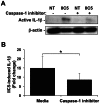A role for uric acid and the Nalp3 inflammasome in antiphospholipid antibody-induced IL-1β production by human first trimester trophoblast
- PMID: 23762324
- PMCID: PMC3675211
- DOI: 10.1371/journal.pone.0065237
A role for uric acid and the Nalp3 inflammasome in antiphospholipid antibody-induced IL-1β production by human first trimester trophoblast
Abstract
Women with antiphospholipid syndrome (APS) are at risk of recurrent pregnancy loss and obstetrical disorders, such as preeclampsia and intrauterine growth restriction (IUGR). Antiphospholipid antibodies (aPL) directly target the placenta by binding beta2-glycoprotein I (β2GPI) expressed on the trophoblast. We recently demonstrated in human first trimester trophoblast cells that anti-β2GPI antibodies (Abs) induce the secretion of IL-1β in a Toll-like receptor 4 (TLR4)-dependent manner. IL-1β secretion requires processing of pro-IL-1β and this is mediated by the inflammasome, a complex of Nalp3, apoptosis-associated speck-like protein containing a CARD (ASC) and caspase-1. The objective of this study was to determine if aPL induce IL-1β production in trophoblast via the inflammasome. Using a human first trimester trophoblast cell line, we demonstrated that a mouse anti-β2GPI mAb and human polyclonal aPL-IgG induce IL-1β processing and secretion, which was partially blocked upon caspase-1 inhibition. Nalp3 and ASC knockdown also attenuated anti-β2GPI Ab-induced IL-1β secretion. Furthermore, aPL stimulated the production of uric acid in a TLR4-dependent manner; and inhibition of uric acid prevented aPL-induced IL-1β production by the trophoblast. These findings demonstrate that aPL, via TLR4 activation, induce a uric acid response in human trophoblast, which in turn activates the Nalp3/ASC inflammasome leading to IL-1β processing and secretion. This novel mechanism may account for the inflammation at the maternal-fetal interface, which causes placental dysfunction and increases the risk of adverse pregnancy outcome in patients with APS.
Conflict of interest statement
Figures




Similar articles
-
Antiphospholipid Antibodies Inhibit Trophoblast Toll-Like Receptor and Inflammasome Negative Regulators.Arthritis Rheumatol. 2018 Jun;70(6):891-902. doi: 10.1002/art.40416. Epub 2018 Apr 25. Arthritis Rheumatol. 2018. PMID: 29342502 Free PMC article.
-
Uric acid induces trophoblast IL-1β production via the inflammasome: implications for the pathogenesis of preeclampsia.Am J Reprod Immunol. 2011 Jun;65(6):542-8. doi: 10.1111/j.1600-0897.2010.00960.x. Am J Reprod Immunol. 2011. PMID: 21352397 Free PMC article.
-
Antiphospholipid antibody-induced miR-146a-3p drives trophoblast interleukin-8 secretion through activation of Toll-like receptor 8.Mol Hum Reprod. 2016 Jul;22(7):465-74. doi: 10.1093/molehr/gaw027. Epub 2016 Mar 29. Mol Hum Reprod. 2016. PMID: 27029214 Free PMC article.
-
Pregnancies complicated with antiphospholipid syndrome: the pathogenic mechanism of antiphospholipid antibodies: a review of the literature.Ann N Y Acad Sci. 2007 Jun;1108:505-14. doi: 10.1196/annals.1422.054. Ann N Y Acad Sci. 2007. PMID: 17894016 Review.
-
The inflammasome: a caspase-1-activation platform that regulates immune responses and disease pathogenesis.Nat Immunol. 2009 Mar;10(3):241-7. doi: 10.1038/ni.1703. Nat Immunol. 2009. PMID: 19221555 Free PMC article. Review.
Cited by
-
Human fetal membrane IL-1β production in response to bacterial components is mediated by uric-acid induced NLRP3 inflammasome activation.J Reprod Immunol. 2022 Feb;149:103457. doi: 10.1016/j.jri.2021.103457. Epub 2021 Dec 2. J Reprod Immunol. 2022. PMID: 34875574 Free PMC article.
-
Human fetal membranes generate distinct cytokine profiles in response to bacterial Toll-like receptor and nod-like receptor agonists.Biol Reprod. 2014 Feb 27;90(2):39. doi: 10.1095/biolreprod.113.115428. Print 2014 Feb. Biol Reprod. 2014. PMID: 24429216 Free PMC article.
-
Anti-β2GPI/β2GPI induces human neutrophils to generate NETs by relying on ROS.Cell Biochem Funct. 2019 Mar;37(2):56-61. doi: 10.1002/cbf.3363. Epub 2019 Jan 30. Cell Biochem Funct. 2019. PMID: 30701573 Free PMC article.
-
Trophoblast Cell Function in the Antiphospholipid Syndrome.Biomedicines. 2023 Sep 30;11(10):2681. doi: 10.3390/biomedicines11102681. Biomedicines. 2023. PMID: 37893055 Free PMC article. Review.
-
Antiphospholipid Antibodies Inhibit Trophoblast Toll-Like Receptor and Inflammasome Negative Regulators.Arthritis Rheumatol. 2018 Jun;70(6):891-902. doi: 10.1002/art.40416. Epub 2018 Apr 25. Arthritis Rheumatol. 2018. PMID: 29342502 Free PMC article.
References
-
- Tincani A, Bazzani C, Zingarelli S, Lojacono A (2008) Lupus and the antiphospholipid syndrome in pregnancy and obstetrics: clinical characteristics, diagnosis, pathogenesis, and treatment. Semin Thromb Hemost 34: 267–273. - PubMed
-
- Meroni PL, Borghi MO, Raschi E, Tedesco F (2011) Pathogenesis of antiphospholipid syndrome: understanding the antibodies. Nat Rev Rheumatol 7: 330–339. - PubMed
-
- Berman J, Girardi G, Salmon JE (2005) TNF-α is a critical effector and a target for therapy in antiphospholipid antibody-induced pregnancy loss. J Immunol 174: 485–490. - PubMed
Publication types
MeSH terms
Substances
Grants and funding
LinkOut - more resources
Full Text Sources
Other Literature Sources
Miscellaneous

